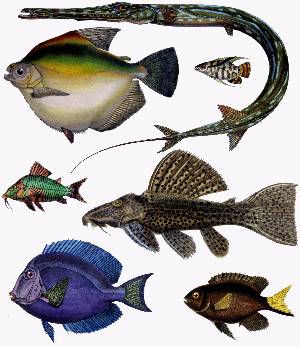MSU helps resolve a 50-year-old fish controversy
An international consortium that includes Michigan State University researchers has solved an evolutionary quandary that’s been the subject of debate for five decades.

Michigan State University Associate Professor Ingo Braasch (right) and Andrew Thompson, who worked on the new report in Science as a postdoctoral scholar at MSU. Thompson is now an assistant professor at Western Michigan University and an adjunct assistant professor at MSU. Credit: Matt Davenport
Publishing its results earlier this month in the journal Science, the team’s genomic analyses conclusively resolve which modern fish lineage branched off earliest within the tree of life. The findings shed new light on the evolutionary history of fishes and the understanding of evolutionary processes.
“By verifying how lineages are related to each other, it becomes possible to reconstruct the last common ancestor of the modern fishes, the so-called teleost fishes,” said Ingo Braasch, an associate professor of integrative biology in the College of Natural Science at MSU. “This is a prerequisite to figuring out how fish are related to one another and understanding vertebrate evolution in general.”
Braasch and his team contributed genetic sequence information and analyses on one of the fish tied up in the controversy. All told, the GenoFish Consortium that published this paper generated new genome sequences for seven fish species and involved researchers from 18 different institutions across the United States, Asia and Europe.
The project was led by Yann Guiguen of the French National Research Institute for Agriculture, Food and Environment as well as Hugues Roest Crollius and Camille Berthelot of INSERM, the French National Institute of Health and Medical Research.

Trees of life of teleost fishes representing the two hypotheses of the controversy and its resolution in the present study. Credit: Courtesy GenoFish Consortium
Understanding the history of species through their evolutionary relationships is a key issue and is regularly the subject of scientific controversy. This particular controversy centered on which group of modern fish was the first to branch off from the others: the eels or the bony tongued fishes.
“They’re called bony tongues because they literally have bones in their tongues,” said Braasch, whose team studied the goldeye species of bony tongue fish.
Both eels and bony tongues belong to what are called teleost fishes, which first appeared toward the end of the Jurassic period. Today, teleost fishes are the largest group of modern fishes and include more than 30,000 species. Approximately half of all living vertebrates — animals with backbones — are teleost fishes.
In the 1970s, researchers posited that bony tongues were the earliest branching group, based solely on anatomical criteria. In the 1990s, studies using DNA sequences to help reconstruct evolutionary history named eels as the first group to diverge from the others.
The new study, using the most complete genetic and genomic analyses to date, arrived at a new conclusion. That is, neither of the two previous hypotheses were correct.
Rather these two lineages belong to a single group, which the GenoFish Consortium has christened “eloposteoglossocephalans.”
This also means that it was actually a third group of fishes, called clupeocephalans, that branched away first. Clupeocephalans include tuna, perch, salmon, pufferfish, zebrafish, goldfish and most other modern aquarium fishes.

From a technical standpoint, what makes this study unique is how it leveraged the complete genomes of different species, Braasch said. Researchers not only examined different DNA sequences, but they also studied how the same genes were arranged along the chromosomes of different fish species.
Braasch compared the genome sequencing efforts to reconstructing the encyclopedia of teleost evolution. When scientists first started sequencing the DNA of different fish, the community began learning the words that were used in the history text, but it remained difficult to see the organization of the DNA sequence into the books, or chromosomes.
As technology has evolved, scientists could see full chromosomes and genomes. Now, researchers had the words and understood how those were put together on a page and how those pages were arranged into the different books of the encyclopedia.
“Before now, it basically wasn’t possible to read the entirety of books at once. We knew the text, but not how it was organized,” Braasch said. “So what this study shows is a novel way of analyzing the organization of genomes into chromosomes and this principle can be applied to reconstructing any branch in the tree of life, not just the fish branch.”Banner image: Trees of life of teleost fishes representing the two hypotheses of the controversy and its resolution in the present study. Credit: Courtesy GenoFish Consortium